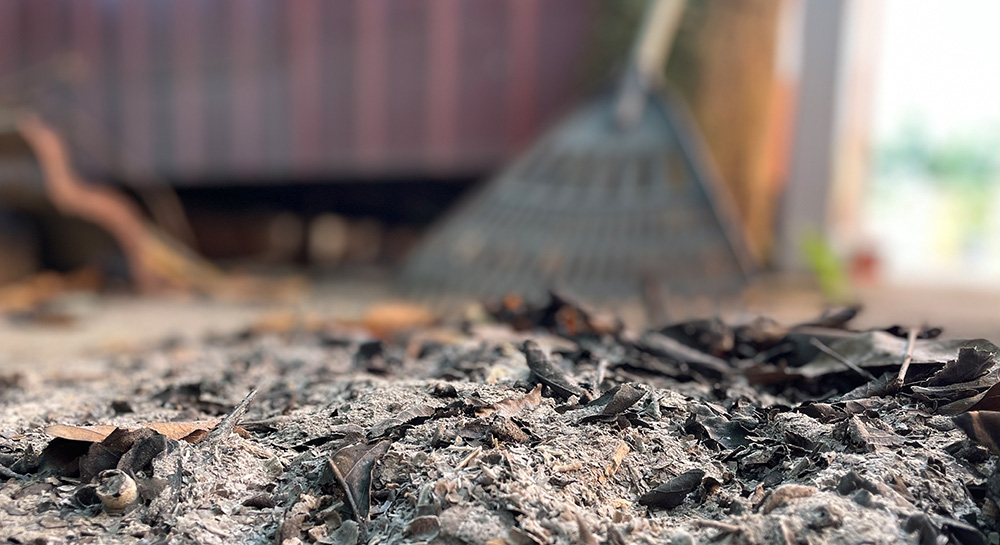
The Eaton Fire sparked on the evening of Jan. 7. Later that night, Pasadena Unified School District officials knew it was going to forever change the lives of its community.
Public Information Officer Hilda Ramirez Horvath said that the district had already activated its emergency operations center in anticipation of severe winds. Leaving work around 9 p.m., smoke was in the air with scattered ash and downed trees setting an unsettling scene. The district had announced earlier that schools would be closed the following day due to the fire.
Wanting to focus on timely communications with families and knowing that traveling home wasn’t realistic given the conditions, she opted to check into a nearby hotel. While standing in the registration line surrounded by evacuees, “we started hearing rumors that a school was burning,” she said. “And at that moment, it was really clear standing there that this was huge.”
Upwards of 725,000 students across Los Angeles, San Diego, Ventura and San Bernardino counties are estimated to have been affected by the wildfires that devastated parts of Southern California in January. Encounters with unforgiving blazes have become all too common for local educational agencies up and down the state in the past decade due to a combination of natural and human-caused factors like heat waves, droughts, high winds, dry vegetation, issues with infrastructure such as power lines and even arson.
In Pasadena USD, roughly two-thirds of its 14,000 students lived in evacuation zones and 50 percent of its 2,739 employees evacuated. As of May, 987 families and 120 employees had reported losing their residences during the Eaton Fire, which burned for 24 days, and countless others were displaced. Five school sites were either destroyed or significantly damaged.
With more than 30 years in the field, district Superintendent Elizabeth Blanco said that the fire and its aftermath has been one of the most challenging experiences of her career.
Safely returning students to school as promptly as possible was a priority, but environmental and soil testing, debris removal and other measures had to occur to make that possible. In the meantime, while campuses remained closed from Jan. 8-22, students who were able to (some lost their district-issued devices in the evacuation process and replacements have since been provided), could participate in self-directed learning modules. Through their own means and via partnerships with organizations like the Pasadena Educational Foundation, services like grab-and-go meals, water, clothing and gift card distribution and child care were made available. Leadership assisted in facilitating access to Federal Emergency Management Agency (FEMA) services and insurance experts.
District staff were among the volunteers. “Something that was really amazing to me was how everybody showed up regardless of what their own situation was. We had people that had lost their homes who, on day three, were passing out food and water to others,” Blanco said. “Just by the nature of being educators and the people that we are, there was this natural commitment to, ‘I’m going to be there for the students.’”
And the district was there for impacted staff members as well. Through support from the state, short-term housing assistance was hastily established and prior to the district’s phased reopening from Jan. 23-30, professional development on restorative practices was held.
During reopening, an emphasis was placed on social-emotional learning (SEL). Luckily, the district has long promoted this curriculum and overall wellness, a foundation which Blanco hopes serves students as they manage their lives now. She has witnessed them lean on each other as a support system.
Logistically, a handful of schools had to be relocated, including three charter schools, and portables were deployed to accommodate students at shared campuses as needed.
The district’s Center for Independent Studies is a key resource for students who are temporarily living outside of the attendance area, and academic recovery is being addressed through methods like summer programming. The replacement of instructional materials is ongoing. Despite disruptions, 14 seniors found success in dual enrollment — graduating with a high school diploma and an associates degree.
End-of-the-year performances, dances and graduations have been sweet moments of togetherness and celebration.
Moving forward, the superintendent’s leadership team will balance recovery efforts and advancing innovations that were underway before the Eaton Fire. Blanco noted that students, families and staff will all require long-term support, as does the district. “Looking ahead, we face financial challenges,” she said. “With many families displaced by the fires, we anticipate a substantial decline in enrollment, which would have a significant impact on our revenues. Without a multi-year ‘hold harmless’ funding policy from the state, the district faces a significant revenue loss. Rebuilding schools will span years and require a sustained investment.”
Butte County’s Paradise USD is no stranger to managing recovery efforts following a wildfire. The 2018 Camp Fire affected all but one of the 13 campuses the district had at the time, according to Board President Melissa Crick.
Years later, the district uses its experiences to help others, including Pasadena USD. After the Eaton Fire broke out, the districts connected and Pasadena utilized insights from their conversations to take significant initial actions like getting the community together as soon as possible to foster connection.
Immediately following the Camp Fire, Crick recalled knowing that the student population would not return to its base as “the losses were just too great,” but keeping as many children as possible in the district was a goal.
They took stake of insurance and bond funds and, in collaboration with the community, began to make recovery plans for the coming years “to make sure that we were serving the students that were actively accessing our campuses, but also looking ahead to the future,” Crick said.
Noting that handling matters related to facilities during recovery is “unbelievably complicated,” she said the district has invested in constructing state-of-the-art campuses and modernizing others while weighing the pros and cons of ideas like using modular buildings to address immediate needs. Paradise USD is preparing to break ground on a new elementary site soon, Crick added, because of demand, and ribbon cuttings serve as monumental milestones for locals.
Through it all, governance teams must consider ongoing factors like an LEA’s finances and staffing needs.
As a whole, Crick said that recovery is going well, as evidenced by data like improved performance in mathematics as reflected on the California State Dashboard. Recovery isn’t linear, however, and the district has had to stay vigilant in how it handles issues like fatigue in leadership or addressing young people’s social-emotional needs.
Partnering with community organizations and leaning on the county office of education — which Crick said, “should be your greatest resource,” as it’s a connection to county services and neighboring districts — can fill needs. Butte COE’s trauma-informed arts educators initiative, for instance, has brought intentional programming to Paradise USD students to support their well-being.
Crick said that these relationships and the people of Paradise have been “the magic to recovery,” adding that, “We are so blessed with just such integrity across the leadership in our community and the district and town and every nonprofit organization.”
Though Blanco’s leadership team at Pasadena USD is relatively new to working together, she stated that their respective expertise and appreciation of each other, which makes them a strong group, was invaluable. “You want to have the right people on the team before you have to face anything like this,” Blanco said.
Importantly, she added that the school board, who was always in the loop during January’s events, exercised their trust in the team and gave them space to work. Crick asserted that relying on internal leadership is essential as LEAs will often be inundated with advice from others after a disaster. “There’s nobody that knows your community and your schools better than you do,” she said. LEAs shouldn’t be afraid to express what support and resources their community would like or may not find helpful at various points.
In Pasadena USD, Blanco said decisions that have been made related to reopening schools were based on the guidance of environmental safety and public health agencies and that the district established multi-platform, consistent communication with the public early on, including launching a webpage. Transparency was, and is, imperative.
Some best practices that emerged in Pasadena, many of which Crick echoed, include:
- Building cross-agency emergency response partnerships prior to disaster
- Drafting instructional continuity plans with built-in enrollment flexibility
- Having updated site plans/maps for campuses and understanding the LEA’s insurance policy and coverage as well as labor contracts
- Establishing a Wildfire Recovery Framework. Learn about the district’s framework on the CSBA blog at blog.csba.org/pusd-fire-framework
Even in times of chaos, Blanco stressed the importance of remaining committed to the larger organizational vision. For leaders, taking time for oneself to process situations is also necessary.
A March report by EdTrust and UndauntedK12, The Impacts of the Los Angeles Wildfires on Students: Lessons for Schools Nationwide, offers a look at the repercussions that the fires had locally and provides proactive recommendations for those in the field.
While some LEAs were closed for a few days, others were shut down for upwards of 10 days. According to the report, missing just a week of school can be detrimental to students and can cause two- to three-weeks’ worth of learning loss.
Of the impacted students, the most vulnerable populations were disproportionately affected. More than one in 10 were individuals with disabilities. Three-fourths were socioeconomically disadvantaged, two-fifths were multilingual learners and two-thirds were Latino.
Young people and their families faced, and continue to encounter, challenges like loss of access to vital community resources, as well as trauma and displacement.
“School closures exacerbate existing trauma,” the report states. “Many families have been displaced without access to shelter, clothing, and food, which can affect students’ emotional well-being and academic performance. Students may have been impacted by parental stress, deaths, or traumatic injuries in their communities. The psychological strain on students, their families, and educators due to ongoing evacuations and wildfires will not go away overnight. Even when students return back to school, they will require robust support of their physical and mental health.”
Because extreme weather events are becoming increasingly frequent, the report highlights the national need for climate-resilient infrastructure to foster resilience in schools and ensure equitable recovery.
Recommendations for LEA leaders include reviewing facilities master plans with a focus on climate-resilience; developing emergency response plans and safety guidelines that cover regional risks related to extreme weather; preparing to support mental health needs; and determining root causes that could hinder equitable access to learning-ready facilities.

To aid LEAs, CSBA has a compilation of original, partner, state and federal wildfire preparedness and recovery resources at csba.org/wildfire.
As for what would be helpful for LEAs after disaster strikes, Pasadena USD’s Blanco noted a desire for guidance and/or legislation on how to react to wildfires on topics like soil testing and site cleaning for urban, suburban and rural settings. Although there is information available on preparing LEAs for such events, “solid guidance on how to take care of schools after the fire that are in a fire zone or near a fire zone, I think would really help,” she said. Additionally, Blanco is advocating for longer emergency/disaster funding protections.
Similarly, Paradise USD’s Crick said legislation around recovery would be beneficial, specifically creating a standard around hold-harmless funding. “We have a collective responsibility to make sure that we are creating the simplest path to recovery because it has a huge impact to our students,” Crick said.
